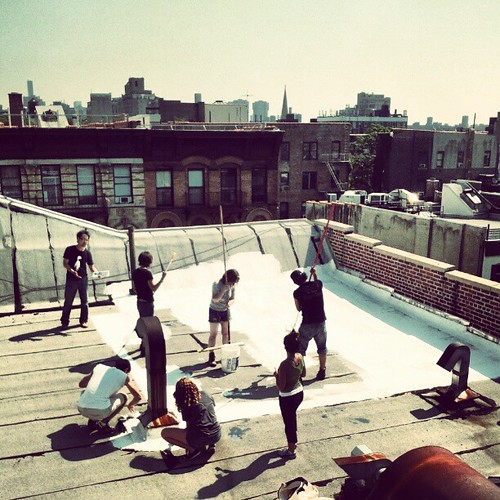The building that houses La MaMa got a new mural back in May, and now it’s getting another paint job – but not in the name of art.
The White Roof Project laid down a first coat of white paint on the theater’s rooftop on Wednesday, adding another 7,000 square feet of solar-reflective white roof to the neighborhood in an ongoing effort to reduce carbon emissions and encourage energy efficiency.
Juan Carlos Piñeiro Escoriaza, the project’s founder, told The Local that the Lower East Side is one the heaviest energy users in the city. “Our efforts there get you more ‘bang for your buck’ every time a roof is coated white,” he said, adding that he wanted to have contiguous rooftops along East Third and Fourth Streets between Bowery and Second Avenue painted white by the end of 2013.
Data is still being collected on the degree to which energy costs have been lowered in the 20 buildings that got white roofs last summer, but Mr. Piñeiro Escoriaza said the top floors of the buildings were noticeably cooler. “We’ve measured the temperature inside the building on a 94-degree day outside, and inside it was as cool as 80 degrees,” he said. “We did not even need to turn the A/C on. Compare that with the inside of a building with a black rooftop: 105 degrees.”
Phoebe Stern, Director of Operations for Fourth Arts Block, a partner in the project, concurs. The organization has an office on the ground floor of 59-61 East Fourth Street and rents the top floor to Downtown Art as subsidized dance rehearsal space. The seven-story building’s roof was painted white last summer. “Neither our floor nor that top floor has air conditioning,” said Ms. Stern. “Yet when I go up there, their space isn’t any hotter than our office, six floors below. It’s impressive.”
Valois Mickens, a resident of 56 East Fourth Street, which also received a white roof, said she couldn’t determine her energy-saving costs because she had just changed providers, but she detected a strong reduction in temperature in the building’s stairwell and hallways. “There are no windows and little circulation in the hallways. It used to be extremely hot. I’m asthmatic and would have difficulty climbing the six floors my apartment.” Since the roof was painted, she said, the stairwell and hallway leading to her top floor apartment has been much cooler. “I’ve definitely noticed that change,” she said.
La MaMa isn’t the only local theater to go white. Last month, Theater for the New City announced that it would install a white roof on June 21. A statement read, “Our hope is to collaborate with our local public school, P.S. 19, to promote a program where students interested in urban gardening will be given the hands-on experience on our roof.” An employee at the theater confirmed that the roof had been installed.
After the East Village pilot program is complete, Mr. Piñeiro Escoriaza said, it will go worldwide: he’s hoping to partner with other environmental agencies around the world so that 5 percent of rooftops are white by 2030, by which time, savings in carbon emissions are expected to be 24 billion metric tons. It’s an ambitious plan, but one with symbolic meaning. “That happens to be exactly how much the world emitted in 2010,” said Mr. Piñeiro Escoriaza. “So, in essence, this solution would be like turning the world off for an entire year — while also saving on individuals energy bills year in and out.”





